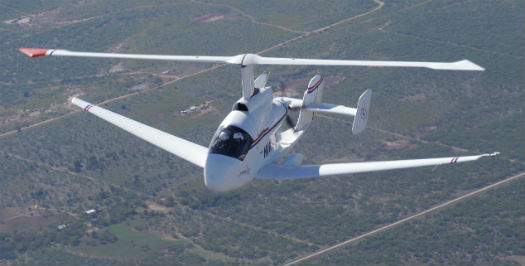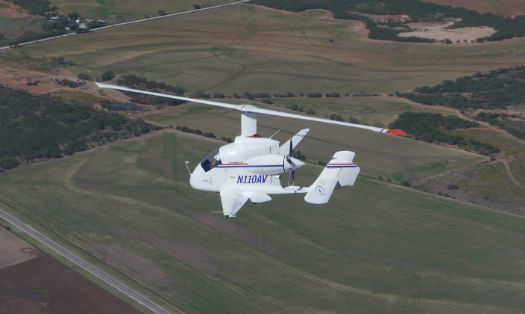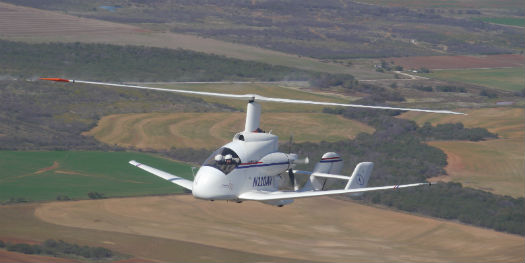
Jay Carter believes the unique slowed rotor compound design of his single-engine fixed-wing autogyro will revolutionize VTOL flight. Carter Aviation Technologies Photos
The Carter Aviation Technologies PAV-II is proof that technological innovation can come in all shapes and sizes. While billions of dollars around the world are being poured into the technology behind various high-speed vertical takeoff and landing (VTOL) tilt-rotor and coaxial rotor aircraft, Carter Aviation Technologies’ president and CEO, Jay Carter, believes it’s the unique design of his single-engine fixed-wing autogyro that will revolutionize VTOL flight.
A true inventor whose company currently holds 22 patents in the aviation industry (and has six more pending), Carter is incessantly driven to push boundaries. He could have retired in 1992 after selling his innovative rotor-like technology to the wind turbine industry, but he had unfinished business; in lieu of retirement, he convinced his wife to let him build an autogyro for his family. He couldn’t afford a certified engine, so he modified a Corvette engine he bought for US$10,000. And so it was: Carter Aviation Technologies was born.
While engineering his machine, Carter said he came to discover solutions to conundrums that have been puzzling aviation engineers for years. After over 20 years of painstakingly proving his theories, he has now created a VTOL aircraft that can successfully fly over 200 mph — the PAV-II (the PAV standing for Personal Air Vehicle), which was displayed at the Helicopter Association International Heli-Center at EAA AirVenture Oshkosh 2014 in July. However, Carter has no intention of stopping the company’s development there: according to his company’s website, a 1,200-hp gas turbine powered aircraft is in the works, which will allow it to cruise at predicted airspeeds of 300 mph. Carter said a maximum speed of over 500 mph is possible by slowing the rotor to keep the tip speed of the advancing blade below Mach 0.9.
Carter has used his technology to break the Mu-1 barrier with both his original and his improved PAV-II prototypes, meaning that he was able to slow the rotor tip speed to at-or-below the aircraft’s airspeed. At high speeds, the PAV-II rotor mast tilts fore and aft, lining the rotor disc up with the airstream as more of the lift is provided by the wing, creating virtually zero pitch and eliminating most of the drag and any possibility of retreating blade stall. In fact, from a drag standpoint, this makes the rotor virtually disappear — Carter said the PAV-II rotor generates 27 times less rotational drag and 5.5 times less total drag by reducing the rotor rpm by 1/3. “That,” he told Vertical, “is the secret sauce.”

Slowing rotor speeds to achieve higher cruise speeds is not a new idea: prototypes developed in the late 1950s and early 1960s achieved forward airspeeds of over 200 mph, but also had stability and vibration issues. Carter, however, was not fazed by their examples. “People told me it was impossible, but I didn’t give up, and angel investors believed in what I was doing and wanted to be a part of changing aviation,” he said enthusiastically. “Other people had businesses backing them that weren’t willing to continue investing. So, I figured out what the issues were and how to solve them.” He added that some former naysayers, who are prominent figures in aviation engineering, provided “sweat equity” to help make his project a reality. Carter explained that a large, open rotor, is the single most efficient means to achieve vertical lift. In hover, CarterCopters perform much like a conventional helicopter, but the big difference occurs in cruise flight. As the aircraft accelerates after takeoff and converts from vertical to translational lift, the wings pick up more and more of the lift share. As the rotor becomes less loaded (with the wing providing most of the lift), it is declutched from the drive system and enters autorotation.
In addition to the slowed rotor technology, the PAV-II has a patented weighted rotor tip system, which creates high inertia. The result is a literal jump takeoff from stored energy in the rotor. The PAV-II can also hover on this stored energy for 10 to 15 seconds. Carter Aviation Technologies has other prototypes in the works using similar technology that have continuous hovering capabilities. The weighted rotor tips also provide centrifugal force, which allow for the slowing of the rotor blades and act like a gyroscope. This creates stability that resists changes that could occur from gusts and turbulence.
The prop is another patented element on the PAV-II. It has a wide chord to keep it from stalling at static and low speed conditions and has no hub, spindle or bearings. The result is a very efficient flexible prop with no gyroscopic loads at the hub. The propeller spar flexes, so when thrust increases, it cones to balance thrust and centrifugal force. And it is light: a 100-inch diameter prop weighs only 42 pounds.

In terms of safety, Carter said his PAV-II landing gear is capable of absorbing a 1,200-foot-per-minute descent without damaging the aircraft or passengers. “You could lose your engine [in the PAV-II] in the dead of night at any altitude and without being able to see the ground, hold the airspeed at 50 mph and provided there are no obstacles [in the flight path], you won’t hurt yourself or the aircraft on impact,” he said. Additionally, he said the aircraft is easy to fly. “It flies just like a fixed-wing airplane, except that at low speeds, the controls don’t get mushy.”
He also said he believed the PAV-II has an advantage over other aircraft because it measures horsepower and fuel burn very accurately. When the pilot changes throttle to achieve the aircraft’s best lift/drag ratio, a computer program utilizes the governor to operate the propeller at its best RPM for the given horsepower, airspeed and temperature. The prop efficiency is displayed in the cockpit and is updated every half second, and that, coupled with leaning the mixture, allows for the best aircraft efficiency and fuel burn possible. According to Carter, based on flight data at 18,000 feet, the PAV-II’s calculated fuel burn at 25,000 feet will be 11 gallons per hour at 200 mph.
However, one disadvantage of the PAV-II is that when the rotor is slowed, the pilot cannot turn the aircraft very fast because of the rotor’s gyroscopic properties. For this reason, the rotor is slowed as the PAV-II reaches given indicated airspeeds. At 100 rpm, the aircraft can sustain a 10-degree-per-second roll or yaw rate. But, at 200 mph, this doesn’t seem to be a deal-breaker.
Despite Carter’s impressive feat in taking his project this far (given his limited resources and the many engineering challenges overcome), the major challenge of breaking into the mainstream industry still lies ahead. His ultimate goal is to license his technology to either the government or an existing major aviation manufacturer who will develop additional slowed rotor compound aircraft.









